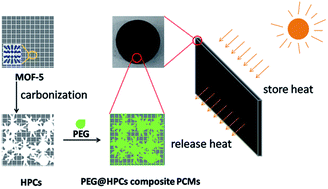Highly porous carbons derived from MOFs for shape-stabilized phase change materials with high storage capacity and thermal conductivity†
Abstract
Highly porous carbons (HPCs) are successfully prepared using a controlled carbonization of metal organic frameworks (MOFs) method. New micropores and mesoporous channels are produced during the migration and aggregation of small ZnO particles in the carbon matrix, while larger nanocavities are created after the evaporation of ZnO particles. The HPCs with high surface area (up to 2551 m2 g−1) and large total pore volume (up to 3.05 cm3 g−1) have high adsorption of polyethylene glycol (PEG) (up to 92.5 wt%) for shape-stabilized phase change materials (ssPCMs). In the PEG@HPCs composites, the nanocavities with a large mesopore volume guarantee the high storage of PEG molecules, and the micropores and mesoporous channels induced surface tension and capillary force to ensure the high thermal stability of the composites. With a high content of PEG and good shape-stabilities, the PEG@HPCs show high phase change enthalpy, which is close to or even higher than that of pure PEG. The thermal conductivity of PEG can also be improved by HPCs.


 Please wait while we load your content...
Please wait while we load your content...